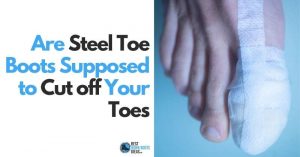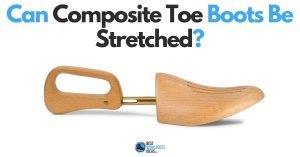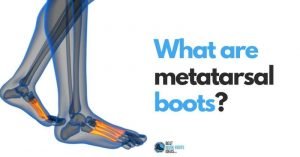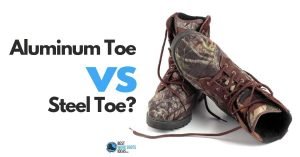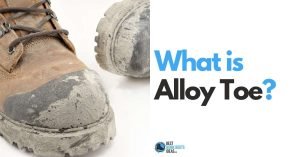How Much Do Steel Toe Boots Weigh? Stop Wondering and Waiting, We’ve Got Answers!
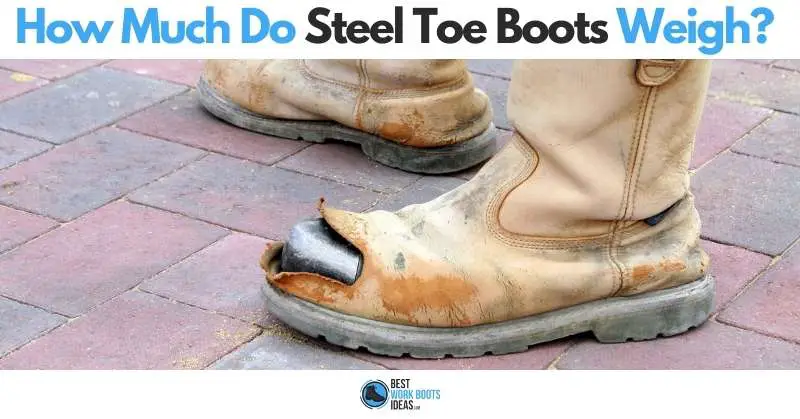
Steel boots range in weight depending on several factors, but an average pair weighs around 3.5 – 4.5 pounds. While this extra weight has a purpose, keeping your toes safe from destruction, there are times when this excess weight comes from other parts of the boot.
Today I’m going to discuss everything about the weight of steel toe boots and how, strange as it may seem, it’s often not the toe that’s adding the weight!
No more waiting; let’s get into weight.
Contents
How Much Does A Steel Toe Cap Weigh?
Steel toe caps can weigh anywhere from .44 – 1.1 pounds (200-500 grams), depending on the design. There are numerous steel toes, some with ventilation holes that reduce weight.
The weight of a particular toe cap also depends on the size of the boot it is made for.
As frustrating as it may be, there is no “this is what it weighs” answer.
For those in the construction trades as I was, perhaps you’ll be a little more sympathetic if I remind you about how customers often ask, “how much is it going to cost and how long will it take?”
Anyone that’s had even a couple of months in the construction trades understands that those two questions are often impossible to answer upfront.
There are just too many variables involved.
Why Do Steel Toe Boots Weigh So Much?
While the steel toe cap makes up a portion of the average 3.5 – 4.5 pound boot, that’s not the only reason why the boots are heavy.
When a steel toe is included in a boot, the manufacturer is likely including many other safety features that add to the weight.
Next, let’s look at all the features besides the steel toe cap that add to the boot’s weight.
Although I’ll link over to the specific definitions as I write, this would be a great time to re-familiarize yourself with the different parts of a work boot, so this will be a quicker and easier read for you.
Outsoles
If you need a steel toe, it’s a safe assumption that you need durable outsoles, as those needs usually go hand in hand.
Outsoles, particularly when made of dense rubber, make up a substantial portion of the boots’ weight.
Heels also vary in size, density, and depth. This is something you should pay attention to when considering the weight of your boot.
Sometimes, like in the case of ironworkers’ wedge boots, the job dictates what type of boot you need. At other times, you’ll have a little bit of leeway in deciding what’s right for you.
Shanks
Someone in need of a steel toe probably also needs the support provided by a steel shank.
This isn’t your only option; however, fiberglass and composite shanks can also give the arch of your foot the help it needs.
On the upside, they’re lighter and don’t conduct temperatures. The downside, they’re usually more expensive.
Some lineman and logger boots are particularly heavy as they often have double shanks.
This is in contrast to the single shank that most “regular” work boots have.
Uppers
The boots ‘ leather uppers are often overlooked as adding to the weight because it’s hiding in plain sight!
The leather’s thickness, density, and weight all vary greatly from one manufacturer to the next.
Nevertheless, there are some general rules of thumb to follow to estimate weight.
Any boot with Goodyear or storm welt construction will be heavier than their cement, blake stitch, or bond welt cousins.
This is simply because more stitches and more materials are used in welt construction methods.
It’s also often the case that the leather used in Goodyear and storm welt boots is thicker.
Just to be clear, between Goodyear and storm, the storm welt is a more durable, more water-resistant construction style and will be the heavier of the two.
Keep in mind, not all work boots will be made with full-grain leather.
There are pull-on work boots often made with rubber or synthetic materials that will decrease the boot’s overall weight.
There are also a growing number of logger boots made with chainsaw- and blade-resistant uppers made of synthetic materials.
These synthetics are usually lighter and stronger, albeit less fashionable than traditional leather.
Throat (Height)
Following the considerations of the boots’ uppers should be the height of the boots themselves.
Is it a 6-inch, 8-inch, or even a 10-12 inch throated boot?
The taller the boot, the more material needed to make it, and the greater weight you’ll be lugging around all day.
By no means am I advocating that those in the lumber or utility industries forego the tall boots they need to stay safe on the job.
I’m just pointing out that the additional leather, interior padding, and the greater number of eyelets required to lace up taller boots are all factors that add to the boot’s weight.
A 6-inch and 10-inch boot will have substantially different weights, even if the steel toe cap is identical.
To prove my point, check out this pair of lineman boots that weigh over 7 pounds!
They don’t even have a steel toe cap either; they use a composite toe, just going to show it’s not all about the toe when it comes to weight.
Are Steel Toe Boots Safe?
If you want to know if steel toe boots are safe then please read a complete article we have written on the topic.
What Are the Alternatives to Steel Toe Boots?
If you’re on a job that requires you to wear OSHA-approved, ASTM f2413 certified boots, you don’t have to get a steel toe.
You always have the option to go with an alloy toe or one of the many composite toe options available on the market.
Again, as with the shank, you’ll find that these alloy and composite alternatives are lighter and lightest compared to steel.
That said, again, you’ll pay for the privilege to have less weight strapped to your feet.
Why Does the Weight of Work Boots Matter?
The weight of your work boots doesn’t matter for the first 10 steps, but after 10,000 or 20,000 over the course of the day, it starts to make a notable difference.
Just think, one extra pound multiplied by 20,000 steps in a day, and that is an extra 40,000 pounds your body has lifted.
Steel toe boots, in particular, can cause back pain, and the added weight can cause problems for the feet and body in general.
You don’t have to take my word for it though, here’s an academic study that thoroughly covered the topic.
Your purpose for your boot can also be a factor.
For example, if you’re going hiking, heavy boots won’t be your ideal choice as you’ll want to be as light and flexible as possible.
What’s the Best Way to Know the Weight of a Particular Pair of Boots
Ask the manufacturer or check their website!
If the weight isn’t listed on the webpage or the actual shoe box (yes, if you’re in a real-life shoe store), you can always send an email or message to the brand.
I regularly reach out to manufacturers in the process of writing these articles, and they’re usually quite good about getting back to me.
I know that seems like a silly answer, “just ask them,” but not all information is immediately available online.
To determine the actual weight of the toe cap itself, I had to look through numerous toe cap manufacturers before I found a handful that actually stated their product’s weight.
As I said at the beginning of this article, that weight ranged from about a half-pound to a pound.
It’s in a company’s best interest to give accurate information regarding their products, so they tend to do so.
I recall writing an article about the best boots for asphalt workers, and there was one pair that wasn’t clear about the outsoles’ heat resistance.
I wrote them, and I’m glad I did, as they acknowledged that while the boots were good for “general heat,” they would melt if exposed to the heat of fresh asphalt!
No More “Weighting,” You’ve Finished the Article
I appreciate you taking the time to look into the weight of steel toe boots.
This is one of those instances where there’s more than meets the eye.
I hope you better understand how other design features can play a role in a boot’s weight, not just the steel toe.
If you’re looking for lightweight steel toe boots then you may want to consider safety footwear that may not have all the features listed above.
However, you should also exercise caution and always refer to your PPE manual.

